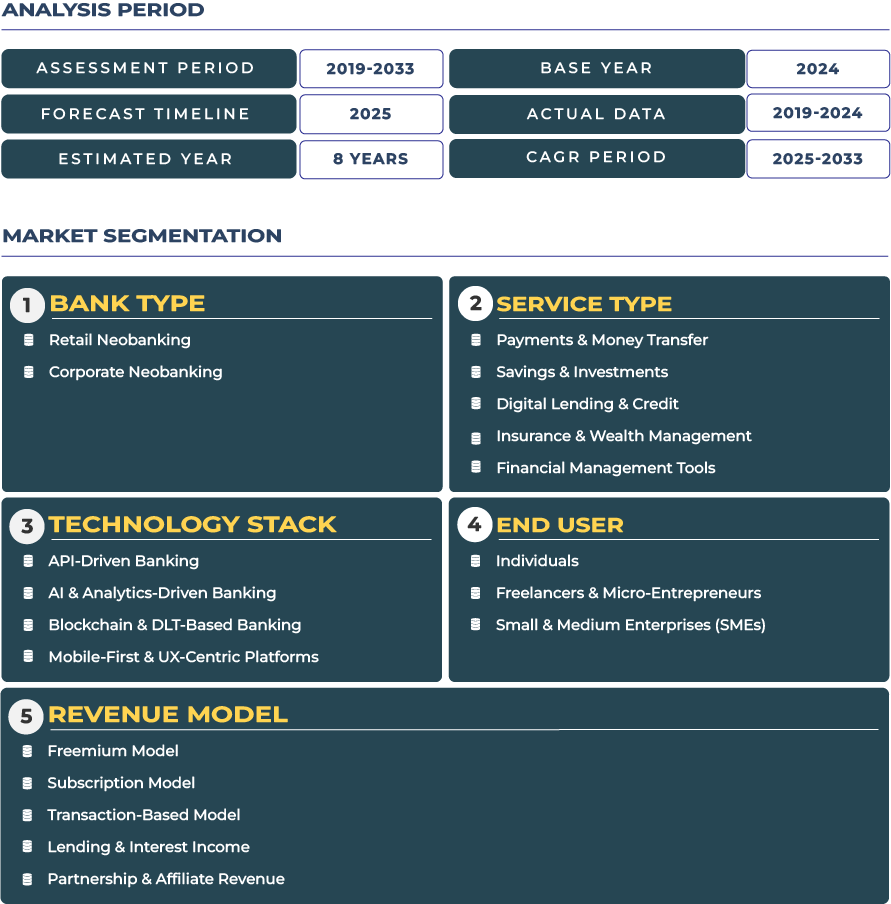Open Banking & PayTo Innovation Platforms Spearhead Australia Fintech Neobanking Market Surge
Australia is positioning itself as a model for secure, interoperable open-finance infrastructure, where technology vendors that design, develop and license digital-banking platforms and modular banking capabilities are gaining traction. Platform providers are deploying virtual-account engines, PayTo-based direct debit modules, embedded SME-treasury stacks and real-time payment rails aligned with the New Payments Platform Australia (NPP). The fintech neobanking market in Australia is projected to grow significantly, and vendors supplying licence-agnostic, low-code banking stacks are well-positioned to participate in this evolution. This growth is underpinned by strong smartphone penetration, regulatory reforms such as the Consumer Data Right (CDR) and SME cloud-treasury adoption. As technology providers enable digital-first business banking flows, subscription billing, FX wallets and next-gen compliance modules, the industry outlook is robust. Firms that can deliver modular core-banking APIs, embedded wallets and real-time settlement capability will lead the Australia fintech neobanking landscape.
Australia Fintech Neobanking Market: Open Data Frameworks and PayTo Innovation Redefine Digital Banking Platforms
Drivers & Restraints – PayTo Integration and Cloud Accounting Propel Vendor-Led Digital Banking Evolution
Australia fintech neobanking ecosystem is undergoing rapid expansion, driven by regulatory momentum and technology maturity. The combination of Consumer Data Right (CDR) and PayTo instant debit mandates has positioned fintech vendors as critical enablers of next-generation financial experiences. These firms supply modular payment engines, consent management APIs, and account-to-account (A2A) connectivity layers that empower both SMEs and retail users. As open-banking interoperability grows, vendors are enabling seamless integration between neobanking cores, ERP systems, and cloud-accounting tools—reducing reconciliation friction for small enterprises. However, the market faces challenges including increasing exposure to instant-payment fraud, high compliance costs, and fragmented technology adoption among smaller financial institutions. Despite these restraints, vendor innovation around secure API authentication, fraud-detection analytics, and embedded audit trails continues to strengthen digital banking resilience, making Australia a reference model for API-first open finance.
Trends & Opportunities – A2A Subscriptions, SME Treasury Cloud, and PayTo Billing Define Platform Expansion
The key trend shaping the Australian fintech neobanking market is the convergence of open banking and SME financial automation. Vendors are embedding A2A subscription payment rails and SME treasury cloud modules that integrate with ERP tools, transforming how mid-market firms manage liquidity and vendor payouts. As adoption of PayTo accelerates, opportunities are emerging in merchant billing automation, GST reconciliation wallets, and invoice-triggered instant settlement. Fintech vendors specializing in real-time payment APIs, consent dashboards, and micro-escrow systems are tapping into high-value business segments such as logistics, e-commerce, and professional services. In major hubs like Sydney, Melbourne, and Brisbane, technology providers are also enabling modular credit assessment and spend-control dashboards that help businesses optimize cash flow while ensuring compliance with the Australian Prudential Regulation Authority’s data-security standards. This shift marks a move toward composable digital-banking architectures that align with Australia's broader open finance and digital-economy objectives.
Competitive Landscape – Accounting Integrations, CoP Check, and SME Channel Partnerships Redefine Platform Strategy
The competitive landscape of the Australian fintech neobanking sector is defined by rapid vendor alignment with regulatory frameworks and ecosystem collaboration. Local leaders such as Ferocia Volopay are leveraging modular neobanking platforms to deliver intelligent automation, accounting integrations, and PayTo-ready payment orchestration. Vendors focusing on “Confirmation of Payee” (CoP) systems are reducing transaction fraud and operational errors by embedding account-verification APIs and risk-monitoring engines directly into neobanking workflows. Partnerships with cloud-accounting ecosystems such as Xero and MYOB are redefining SME channels through simplified onboarding and automated credit reconciliation. Furthermore, collaborations with regulatory agencies and data intermediaries are promoting interoperability between consent-driven APIs and fraud-prevention architectures. As compliance, automation, and open-access infrastructure converge, the Australian fintech neobanking market is emerging as one of the most vendor-driven and innovation-ready digital financial ecosystems globally.







